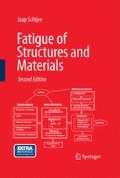Fatigue failures in metallic structures are a well-known technical problem. Already in the 19th century several serious fatigue failures were reported and the first laboratory investigations were carried out. Noteworthy research on fatigue was done by August Wöhler. He recognized that a single load application, far below the static strength of a structure, did not do any damage to the structure. But if the same load was repeated many times it could induce a complete failure. In the 19th century fatigue was thought to be a mysterious phenomenon in the material because fatigue damage could not be seen. Failure apparently occurred without any previous warning. In the 20th century, we have learned that repeated load applications can start a fatigue mechanism in the material leading to nucleation of a small crack, followed by crack growth, and ultimately to complete failure. The history of engineering structures until now has been marked by numerous fatigue failures of machinery, moving vehicles, welded structures, aircraft, etc. From time to time such failures have caused catastrophic accidents, such as an explosion of a pressure vessel, a collapse of a bridge, or another complete failure of a large structure. Many fatigue problems did not reach the headlines of the news papers but the economic impact of non-catastrophic fatigue failures has been tremendous. Fatigue of structures is now generally recognized as a significant problem.
The history of fatigue covering a time span from 1837 to 1994 was reviewed in an extensive paper by Walter Schütz [1]. Historical milestone papers were collected by Hanewinkel and Zenner [2] and Sanfor [3]. John Mann [4] compiled 21075 literature sources on fatigue problems covering the period from 1838 to 1969 in four books. Since that time the number of publications on fatigue has still considerably increased and it may be estimated to be around 100,000 in the year 2000. Fortunately, consulting the literature on specific topics can now be done with computerized literature retrieval systems.
Access this chapter
Tax calculation will be finalised at checkout
Purchases are for personal use only
Preview
Unable to display preview. Download preview PDF.
References
Schütz, W., A history of fatigue. Engrg. Fracture Mech., Vol. 54 (1996), pp. 263-300.
Hanewinkel, D. and Zenner, H., Fatigue strength. A facsimile collection of historical papers until 1950. Technical University of Clausthal (1989) [historical papers in English and German].
Sanfor, R.J. (Ed.), Selected Papers on Foundations of Linear Elastic Fracture Mechanics. SEM Classic papers, Vol. CP1, SPIE Milestone Series, Vol. MS 137 (1997).
Mann, J.Y., Bibliography on the Fatigue of Materials, Components and Structures, Vols. 1 to 4. Pergamon Press, Oxford (1970, 1978, 1983 and 1990).
Schijve, J., Fatigue of structures and materials in the 20th century and the state of the art. Int. J. Fatigue, Vol. 25, No. 8 (2003), pp. 679-702.
Heywood, R.B., Designing against Fatigue. Chapman and Hall, London (1962).
Schijve, J., Predictions on fatigue life and crack growth as an engineering problem. A state of the art survey. Fatigue 96, Proc. 6th International Fatigue Congress, Berlin, Vol. II, G. Lütjering and H. Nowack (Eds.). Pergamon (1996), pp. 1149-1164.
Editor information
Editors and Affiliations
Rights and permissions
Copyright information
© 2009 Springer-Verlag Berlin Heidelberg
About this chapter
Cite this chapter
(2009). Introduction to Fatigue of Structures and Materials. In: Schijve, J. (eds) Fatigue of Structures and Materials. Springer, Dordrecht. https://doi.org/10.1007/978-1-4020-6808-9_1
Download citation
DOI: https://doi.org/10.1007/978-1-4020-6808-9_1
Publisher Name: Springer, Dordrecht
Print ISBN: 978-1-4020-6807-2
Online ISBN: 978-1-4020-6808-9
eBook Packages: EngineeringEngineering (R0)

